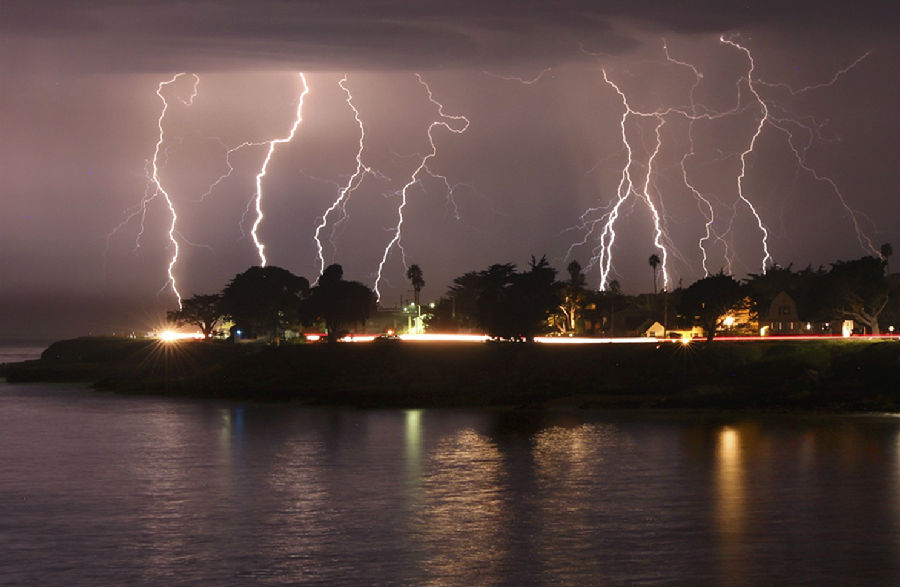On August 16th a monitoring station in Death Valley measured a temperature of 54.4°C (130°F). If confirmed, that would be the highest reliably recorded anywhere on Earth. It may reflect a broader trend of global warming hitting Californians harder than most places. According to the National Oceanic and Atmospheric Administration, temperatures in many parts of the state, including Santa Clara County, which is being scorched by the largest of the fires, rose by 2°C between 1895 and 2018, roughly twice the global average.
8月16日,死亡谷的一個監(jiān)測站測量溫度為54.4攝氏度(合130華氏度)。如果該檢測溫度得到證實,這將是地球上最可靠的記錄。這可能反映出全球變暖趨勢給世界各地帶來了嚴重打擊,其中加州人受創(chuàng)尤為嚴重。根據(jù)美國海洋及大氣管理局的數(shù)據(jù),包括正在遭受最嚴重的野火災(zāi)害的圣克拉拉縣在內(nèi),加州許多地區(qū)的溫度,在1895年至2018年期間上升了2攝氏度,大約是全球平均上升氣溫的兩倍。
The state is drier as well as hotter. California has experienced droughts throughout history, but the one between 2011 and 2019 was the longest and driest recorded. According to a study in Nature Geosciences in 2019, that drought killed almost 150m trees, leading to a state of emergency in 2019 intended to help reduce the huge build-up of flammable dead wood. Too late. Drought returned this year, when the state had its driest February on record (matters improved a bit later). A recent study in Environmental Research Letters by Michael Goss of Stanford University and others found that climate change had doubled the number of days of extreme risk for wildfires in the state during autumn.
加州氣候干旱且炎熱。加州在歷史上經(jīng)歷過干旱,但2011年至2019年間的干旱是有史以來歷時最長、最干燥的一次。根據(jù)《自然地球科學》2019年的一項研究,那場干旱導致近1.5億樹木死亡,也致使加州在2019年進入緊急狀態(tài),意圖幫助減緩易燃枯木的大量增長。但是太晚了。今年旱災(zāi)復發(fā),加州經(jīng)歷了有史以來最干旱的2月(后來情況有所好轉(zhuǎn))。斯坦福大學的邁克爾·戈斯等人最近在《環(huán)境研究快報》上發(fā)表的一項研究發(fā)現(xiàn),氣候變化使加州秋季發(fā)生極端野火災(zāi)害的天數(shù)增加了一倍。

There is some evidence that climate change is also increasing the danger of lightning strikes, which (rather than burst tyres) lit the inferno this season. Northern California’s fires began after a massive electrical storm passed over the Bay Area in mid-August, producing, said CAL FIRE, 11,000 strikes in three days. According to a study published in 2014 in Science by David Romps of the University of California, Berkeley, climate models suggest the number of lightning strikes across the continental United States could rise by about 12% for every degree of global warming (though another study, in Nature, questions the link with climate change).
有證據(jù)表明,氣候變化也會增加雷擊的危險,閃電(而非爆胎)引發(fā)了不息的野火季。八月中旬,一場大雷暴席卷了海灣地區(qū),此后加州北部的野火災(zāi)害拉開序幕,加州消防局表示,這場雷暴在三天內(nèi)發(fā)生了1.1萬次雷擊。根據(jù)加州大學伯克利分校的大衛(wèi)·羅姆斯2014年在《科學》雜志上發(fā)表的一項研究,氣候模型表明,全球變暖每加劇一級,美洲大陸的雷擊次數(shù)可能上升約12%(盡管《自然》雜志的另一項研究質(zhì)疑雷擊與氣候變化的聯(lián)系)。
譯文由可可原創(chuàng),僅供學習交流使用,未經(jīng)許可請勿轉(zhuǎn)載。












